is a comfort, to review our unfortunate history, rich in traitors corrupt, incompetent and evil, meet the angry French who walked the seven seas freeing slaves, he dreamed of rescue Napoleon from his forced exile in St. Helena and was master of California for five days, covered in blue and white flag . A gripping story that has nothing to envy to the exploits of Sandokan, the Red Corsair, Captain Jack Aubrey and Blood. At the approach!
The part of a revolution
The first months of the revolutionary governments of Buenos Aires were very difficult. Only on the waterfront, they faced the mighty fleet that controlled the river de la Plata from Montevideo (in fact, Buenos Aires was blocked and bombed in 1811). The first and improvised armed country, entrusted the command of Juan Bautista Azopardo Maltese sailor, had been destroyed in San Nicolas at the beginning of this year. The chief himself was taken prisoner, and spent the next ten years in a English prison.
The absence of a marina, and the proposed issuance of Fernando VII decided to reconquer the rebellious rioplatenses to grant letters of marque to adventurers of various nationalities. The above issue would end invading Venezuela and New Granada, but just continued on with the idea.
What is a Patent Corso?
The parade was then considered a legitimate way of fighting (1). With some cynicism, one might say that allowing private enterprise to participate in a war, coupled with a belligerent state. The British used it for centuries against their enemies, particularly Spain, and the Americans gave the Perfidious Albion a bit of his own medicine during the war of 1812-1814. Upon completion of this conflict, many Baltimore-based pirates continued in business through patents a nation that had not been nor would ever, the United Provinces of Río de la Plata.
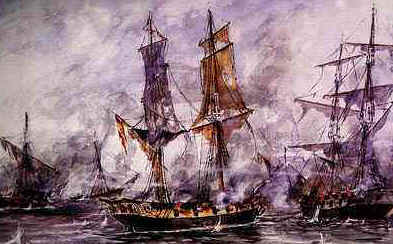 The letter of marque was a contract whereby a State gave an individual the right to attack, seize, plunder or destroy any vessel flying an enemy flag, in exchange for allowing them to stay with some of the booty. Sometimes the country issuing the patent brought the ship, or at least supplies, food and some of the crew, the pirate (or owner) should bear the remaining costs. The campaign did not usually last more than a year, after which you must return the goods entrusted to the government, and deliver arms and ammunition collected in the catch at sea.
The letter of marque was a contract whereby a State gave an individual the right to attack, seize, plunder or destroy any vessel flying an enemy flag, in exchange for allowing them to stay with some of the booty. Sometimes the country issuing the patent brought the ship, or at least supplies, food and some of the crew, the pirate (or owner) should bear the remaining costs. The campaign did not usually last more than a year, after which you must return the goods entrusted to the government, and deliver arms and ammunition collected in the catch at sea.
In case of shipwreck, the Corsair was relieved from any refund. Should keep a record of what happened in the campaign, as was hoisted at the time of the attack, the flag of the state issuing the patent. The Corsican Hispanic
began in 1814, the year that finally ended with the danger posed Montevideo. Peaked around 1818 and ended in 1823. The Argentine flag ships carried the most important actions. The main areas of action were the South Atlantic and the Caribbean, where they performed about 60 pirates, but there were also attacks in the Pacific Ocean to the Mediterranean Sea. In the heyday of the marque, the city of Cadiz was about to be blocked by English American ships.
From the Banda Oriental operated more than 30 Corsairs with patents granted by Artigas, who captured English ships, and after the invasion of 1816, Portugal. In the Caribbean acted ships of the Great Colombia and Mexico in conjunction with the Argentine privateers, with their base of operations on the island Margarita. Chilean privateers, armed after the independence of his country with the support of Argentine and British sailors, made a number of realistic trade prey base in Lima between 1818 and 1820.
The most important consequences were the loss of privateering and trade impasse that caused the English trade, only Buenos Aires privateers captured about 150 prisoners.
Among the highlights are Irish Guillermo Brown (the creator of the army in Argentina), American David Jewitt (who among other outstanding shares took possession of the Falkland Islands on behalf of the government of Buenos Aires in 1820) and the main protagonist of this story.
Hippolyte André BOUCHARD Paul Bouchard was born on January 15, 1780 in Bormes (2) a town in France near Saint Tropez. Louis was the son of André Bouchard, bartender and then successful manufacturer of cork stoppers, and Therese Brunet.
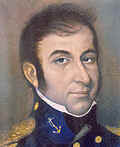 André was a "restless and mischievous child, who liked to talk to the people of the sea and wanted to go to war. Hippolytus describes Bartolomé Mitre Bouchard adult and a dark complexion, dark hair and slanted black eyes, piercing and hard, that "flashed fire."
André was a "restless and mischievous child, who liked to talk to the people of the sea and wanted to go to war. Hippolytus describes Bartolomé Mitre Bouchard adult and a dark complexion, dark hair and slanted black eyes, piercing and hard, that "flashed fire."
After Therese widowed, remarried and her new husband squandered his small fortune. André (unknown date that he changed his name to Hippolyte, Hippolyte), just throws her stepfather through the window. 1798
Hippolytus was left home and joined the French army. He served in the ill-fated campaigns of Egypt and Santo Domingo and became disillusioned with the course of the French Revolution, and ended up migrating to the Río de la Plata in 1809. Bouchard soon began to feel sympathy for the ideas expressed by the sector most radical of the Meeting of May, led by Mariano Moreno, and put his naval knowledge available to the Revolution.
When the patriot government faced the first hostilities on the Rio de la Plata, Bouchard served as second in the first squadron Azopardo Argentina, commanding the brig "May 25." After the defeat of St. Nicholas, March 2, 1811, was unjustly accused of cowardice and irresolution. Substantiate a process, finished acquitted, acknowledging that his duty until he was forsaken by his crew, who panicked in battle.
In the winter of 1811, from a gunboat, Bouchard ships faced the viceroy sent to bomb Elio Buenos Aires. Over the next year he fought in the Paraná, in command of a sloop (the "Boat Bouchard) chasing enemy ships.
In March 1812 a body joined with the organization and self-discipline of Napoleon's army: the brand new Mounted Grenadiers Regiment of San Martín. As a lieutenant, Hipólito Bouchard participated in the Battle of San Lorenzo, 3 February 1813, at which time was not lost: he took "a flag that I put in the hands of VE and started life with the brave officer bearer D. Hipólito Bouchard, "in words of the Liberator. Bouchard always would look with pride earring, a symbol of the riot. Accompanied
San Martín to strengthen the Northern Army, hitherto commanded by Manuel Belgrano. Then it was the army of the Banda Oriental and, after obtaining leave to return to Buenos Aires, was given command of the frigate "Maria Josefa."
In 1813 he married Norberta Merlo, sister of his friend Ramon and daughter of a former English officer who had fought, eight years before Trafalgar. The marriage was suitable for the purpose of moving up the social scale, related to a family the River Plate.
then, Bouchard spoke a particular hybrid of Buenos Aires English and French Provence. Tireless delivery was recognized, while his temperament exalted: it was strange to see him sticking with his sword planazos its most unruly subordinates.
Corso's War in the Pacific
In September 1815, the Supreme Director Ignacio Álvarez Thomas was granted carte blanche to Bouchard, in an expedition funded by Vicente Anastasio Echevarría.
Rosario Echevarria was a lawyer with extensive public life. His parents had dreamed to be a priest, a destination that was responsible for change when he decided to study law and married her cousin, causing a scandal that came to court. Fighter in the British Invasions, owner of a major fortune, was from the beginning of the revolution, behind the scenes, closing and funding agreements the patriot armies. Echevarría would be a providential man for Hipólito Bouchard, who could make enemies with ease.
put forward two pirate ships to Cape Horn to act in the Pacific Ocean. A storm sank the boat commanded by Oliver Russell, Bouchard managed to save his, the corvette "hawk", and round the Cape, despite the opposition of his officers, who wanted to come back and took his insubordination to the edge the riot.
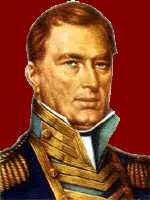 In late 1815, on the island of Mocha, Bouchard met with William Brown to coordinate joint actions. It was a meeting of opposing temperaments, which were projected to the crews, professional, respectful of order and his captain, aboard the Irish, undisciplined and strongly opposed to the command, the French ship.
In late 1815, on the island of Mocha, Bouchard met with William Brown to coordinate joint actions. It was a meeting of opposing temperaments, which were projected to the crews, professional, respectful of order and his captain, aboard the Irish, undisciplined and strongly opposed to the command, the French ship.
The meeting agreed that Brown would be the general commander of the expedition. Bouchard had to accept, but disagreed with the sweeping plans of the Irish, who decided to block anything less than the English fortress of El Callao.
Three small boats corsair fleet (the frigate "Hercules," the brig "Holy Trinity" and corvette "Falcon") harassed realistic lines of communication. Among other feats, sank the frigate Fuente Hermosa "and captured a similar ship, the" consequence ", the January 28, 1816. That ship would then be renamed "La Argentina", the ship that would travel around the world led by Bouchard.
an attack in Guayaquil, William Brown was captured by English forces. Bouchard and Brown's brother, Miguel, negotiated an exchange to retrieve the prisoner, in exchange for ceding much of the booty.
Soon after, Bouchard reported Brown that his boat into water and return to Buenos Aires. Negotiated the division of property, to Bouchard his lot came the "consequence", which gave the "hawk", and held another badly damaged ship, the "Carmen" or "Andalusian", for which he had other plans are left to the officers who had attempted insubordination ...
Top World Tour
"The captain, whose address was on credit 'La Argentina' and fortune, met at each other, physically and morally, the strengths and weaknesses of a hero adventure."
Bartolomé Mitre, "The cruise of Argentina. 1817-1818"
In mid-1816, Hipólito Bouchard landed in Buenos Aires and was assigned to the preparation of a new privateering expedition, sponsored again by Vicente Echevarría.
was made of the few resources that the government could give (cavalry sabers, for operation at sea ...) and prepare the crew, which highlighted a young native who participated in his previous trip, Thomas Spore , who expected a glorious future in the navy of Argentina.
The first problem that had faced the issue occurred when there was no party and adventure almost ended before it began. On the night of June 25, 1817, a discussion on board ended in a fight that should have been suppressed by the Marines, which left two dead and four seriously injured. The Supreme Director Juan Martín de Pueyrredón suspended the game of "Argentina" and ordered an investigation into the causes of the riot. Again, wrist Echevarría policy unlocked the conflict. Two days after the incidents, the issue was finally able to sail.
"Argentina" headed for Africa. In the midst of the sea had intentionally put out a fire, which almost ended with the frigate. To make matters worse, the differences between marine experts from abroad (mainly British) and the Creoles, not at all accustomed to the harsh life of the sea, threatening deepened the tension of the days in the ocean.
Crossing the Atlantic took them just over two months. On September 4, 1817, "Argentina" docked at the port of Tamatave, on the east coast of Madagascar. They inspected four ships (three British and one French), exercising the right to visit that Britain and the United States implemented in Africa since 1812. Bouchard found that it was slave ships, and then freed the slaves and confiscated the supplies. Five sailors from the French slave trade schooner called to enlist in "Argentina", knowing that his captain was French and fought for freedom. As was the British sloop of war "Comway" Bouchard put his captain aware of what worked and left him in charge of surveillance.
"Argentina" then sailed to the Orient in search of enemy ships. Again had to face severe storms, and during the crossing of the Indian Ocean most of the crew fell ill with scurvy. Food became scarce: only biscuits were too hard to be chewed by patients who had wet them to eat. Not a day that does not throw a dead water. On October 18, the captain of an American ship had informed them that more than three years that the English ships of the Society of the Philippines not traded in the ports of India. Hipólito Bouchard knew he had to get to these islands if they wanted to find English.
On 7 November, with a crew decimated, "Argentina" anchored off the island of New Head of Java. They landed the sick and set up tents. After a few days, Fray Bernardo de Copacabana, a priest of Bethlehem who played a doctor on board, decided to try a unique method to retrieve the sick were buried up to their necks in sand. In the words of Hippolyte Bouchard, "which was passed totally died of scurvy After an hour of that was in the land and other got better. This operation was repeated many times until the poor could use their members.
At noon on December 7 were attacked by Malay pirates, famous for his cruelty. Bouchard was not healthy to use artillery cannons, and then ordered his men face danger with guns and knives. The heavy fire prevented the approach of the pirates, whose commander, to be defeated, stabbed two stab wounds to the chest and plunged into the sea. Five of his officers followed suit.
Bouchard ordered the seizure of the ship and the pirates defeated reduction. Four other boats escaped. Following the customs of the sea, Hipólito Bouchard held a council of war prisoners judged. Tested their crimes (including murder of the entire crew of a Portuguese ship had already surrendered), the council sentenced to death pirates, with the exception of some children who were received as apprentices.
Malay pirates were returned to their ship, which was sawed off their sticks. Then, Bouchard ordered the fire. The pirates disappeared under the water shouting "Allah, Allah."
After this adventure, "Argentina" endured a calm sea without wind the passage of the Makassar Strait to the Celebes Sea. Then headed towards the island of Luzon and beyond, Manila, the jewel of the English empire in the East, which sought to block.
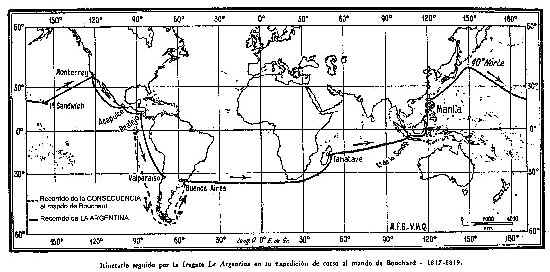
For two months, "Argentina" blocked Luzon, sixteen ships sunk, boarded and captured sixteen other four realistic. The blockade of English trade in Manila caused an inflation of 200% in two months. Hipólito Bouchard decided then to go to China in search of more English ships.
On the trip to Canton, "Argentina" was nearly capsized by heavy storms was faced with the consequence that several crew members were killed nursing. In aggravation, the food became scarce. Bouchard reviewed its plan and headed to the Sandwich Islands, the current Hawaii to refuel and recover the crew.
One of his biographers (Julio Manrique, crew of "Argentina") ensures that, in these days, pondered the French privateer to attack the British island of St. Helena and free his admired Napoleon. The inconvenience of gesture politics and the pressure of the crew to go to Hawaii would have made him give up that ambition. Manrique is the only one of the chroniclers who mention the story (which, in my opinion, does not invalidate his story). But who knows? maybe just one more of the legends surrounding the life of Hipólito Bouchard. Bouchard
in Hawaii
August 18, 1818, "Argentina" anchored in the bay of Kealakehua, one of the Hawaiian islands. Hawaii was then an independent kingdom, ruled by Kamehameha I, a benevolent and progressive monarch who had assembled a small fleet with which connected the islands of the kingdom and trade with China. It was surrounded by European advisers, who advised in dealing with potential imperial era.
Hawaii was also a Mohammedan kind of paradise: it is characterized by sexual disinhibition of their women, beautiful brunette topless, always to the delight of the sailors who arrived in the land ...
Just arrived, Bouchard was found docked in the port, a ship that had been purchased by the king. After careful investigations, Bouchard found that was the corvette Argentina "Santa Rosa" or "Chacabuco", which was preparing to leave, also desire privateer, when "La Argentina" left Buenos Aires. The crew of the "Santa Rosa" had rebelled against the coast of Chile and, after landing his officers, traveled across the Pacific to Hawaii. The men scattered around the island, had taken women and were adapted to local custom. In the absence of crew, the captain sold the vessel to King Kamehameha and left without knowing more about their fate.
Then, a law of the sea, strictly applied, provided that any captain who found mutinous sailors had run without delay, as a warning and to prevent such Cund. At that time the officers were few, most of the crew of any vessel levied consisted of slaves, convicts and captured. Bouchard
arrested a group of men from "Santa Rosa" who were escaping of the islands. Found that the corvette was completely dismantled, stranded at the port, and decided to make the claim with the monarch. Finally the two reached an agreement: the king returned the vessel, would bring men to the crew of Bouchard (one hundred) and it compensated the crown for the purchase of the vessel.
In the memoirs of José Piris, a member of the expedition Bouchard asserts that Kamehameha signed a Treaty of Trade, Peace and Friendship with Hipólito Bouchard, which recognized the independence of the United Provinces of Río de la Plata. Had it done so, Hawaii will be the first country to recognize the independence Hispanic Argentina, for only in 1821, Portugal would do the same, a year before Brazil and the United States and four before Britain. However, neither in the log by Hipólito Bouchard or any other source is based on recognition of the independence of Argentina, made of great magnitude for the chronic lack of facts. Bouchard went
capture the mutineers from the "Santa Rosa" in Kaouai. On Oahu, the largest and richest island of Hawaii, loaded supplies and caught the last mutineers who had been hiding in the woods (one was sentenced to death and the rest to get spanked.) After giving the King Kamehameha military ranks and naming some consuls, decisions for he was not entitled, Hipólito Bouchard went to the east. Next to "Argentina" was the new ship of the fleet, the "Santa Rosa", led by Peter Corney, a former marine who met in Hawaii Bouchard, run the village tavern.
California California was in those years, only a handful of scattered Franciscan missions along the coast, where native religious and lived peacefully. The capital was Monterrey. It grew wheat, alfalfa and fruit trees, and there was a fledgling wine industry. The wines, along with hides, tallow and manufactured from sheep were the major export items. Isolated by the desert, communication was the main sea.
On November 20, 1818, the watchers were arriving in Monterrey "Argentina" and "Santa Rosa". Suddenly the wind stopped and the corvette "Santa Rosa" was stranded. The governor had sent Solá install two batteries on the beach to protect the landing, in fifteen minutes, the corvette was shot and the bridge was filled Argentine casualties.
was the morning of November 24, with men rescued from the "Santa Rosa", Hipólito Bouchard landed with 200 infantry and sailors armed with rifles and spears, along with several guns. The first responses were repelled by guards. The only 25 soldiers English fled in fear.
One of the Hawaiian warriors who formed the crew lowered the English flag and hoisted the banner of Argentina. Since that night, until 29 November, California was in Argentina.
As expected the presence of privateers, the governor had ordered the preventive evacuation of women and children, in addition to the files and money from the Treasury. The expected reinforcements from San Francisco and San Jose did not try to retake the city, but waited the departure of the Argentines.
crews "Argentina" and "Santa Rosa" by pillaging. The Hawaiians had a penchant for marine ... Dresses of women found in homes. The cattle could not be, were killed. Burned the fort, the artillery barracks, the governor's residence and the houses of the English, but both temples were respected as the properties of the Creoles.
attacked shortly after the Rancho El Refugio, the Ortega's ranch, known smugglers of the area who had collaborated with the colonial authorities against the Mexican patriots. Was repeated looting and Monterrey (3).
Then the pirates attacked San Juan Capistrano. Bouchard asked for supplies in exchange for not harassing the population, and they answer the prior bravado. A starting ransacked the mission, well-stocked liquor, but without money or treasure, which had already been evacuated. The return of these men to "Argentina" was somewhat erratic, the degree of intoxication (4).
The small pirate fleet passed over from San Diego and took refuge, to repair ships in Biscayne Bay (now Key Biscayne, always pleasant memory for Argentine tennis). They remained there until January 1819 when they left the south to roam the ports of San Blas and Acapulco. And Central America, attacked Sonsonate, El Salvador, and on 2 April, Realejo in Nicaragua, one of the most important centers of trade and English colonial navy, in addition to the main yard of the Pacific.
Bouchard decided to attack the port with two boats armed with cannons and boats manned by fifty men. Entered the canal before dawn, but were discovered by the watchman at sunrise. Soon all the enemy forces were ready for their arrival, forming a double line of defense, consisting of a brig, a small lugger and a schooner. However, with their meager resources, like pirates captured the port.
The next morning, burned the brig and the schooner, dissatisfied by the poor rescue offered by their owners, and incorporated the small lugger and the ship "Mary Sophia" (anchored at the port) to the fleet of Buenos Aires.
Hipólito Bouchard's adventure in the North Pacific after the confrontation ended with a brig fired shells at the "Santa Rosa", sowing death and injury cover. Without "Argentina" (dedicated to the task of monitoring the prisoners captured in Realejo) Bouchard was going to a tough enemy attack when, suddenly, shortly after going into battle, the ship lowered the flag English aggressor and raised in Chile. It was a pirate ship, captained by a man named Collins, who had faced the "Santa Rosa" English believing. Outraged, Hipólito Bouchard asked will send a surgeon to treat the wounded. In response, Coll left.
The liberation of Peru
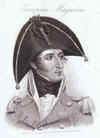 view the damage from the "Santa Rosa" and, aware that San Martin was about to launch its maritime campaign against the English in Peru, Bouchard decided to finalize the issue and heads to Valparaiso. When he reached the port, he found no surprises. By order of the Scottish Admiral Lord Cochrane (the "Lord filibuster" as he called San Martín) were arrested, due to piracy, the cargo was confiscated. Bouchard tried to resist, but the superiority of their opponents made futile defense. He surrendered and was arrested.
view the damage from the "Santa Rosa" and, aware that San Martin was about to launch its maritime campaign against the English in Peru, Bouchard decided to finalize the issue and heads to Valparaiso. When he reached the port, he found no surprises. By order of the Scottish Admiral Lord Cochrane (the "Lord filibuster" as he called San Martín) were arrested, due to piracy, the cargo was confiscated. Bouchard tried to resist, but the superiority of their opponents made futile defense. He surrendered and was arrested.
tortuous trial was initiated, in which his counsel was Thomas Guido. San Martín, Sarratea, Echevarría, O'Higgins, appealed on his behalf. Given the weak charge of the case, the idea that the greed of Lord Cochrane was the incentive to plunder, as shot by elevation to San Martín, who had a silent struggle.
Enraged at the injustice, Colonel Mariano Necochea, partner in San Lorenzo Bouchard, a squad of armed riot police and took "Argentina", ignoring the threats from the authorities. The ship was restored to the French captain.
Once released, Bouchard toured "Argentina" and found the guns and sails had been removed to equip other aircraft. There was no small boat, no ropes, poles, rods or rudder. The blue and white flag, blackened, lay in a corner of the roof. The warehouse was empty, all won on the tour in the Pacific had been looted.
Echevarría had reached new letters of marque and planned to call to Buenos Aires Bouchard, to operate their fleets on the coast of Argentina, but the sea had other plans. Neither he nor his subordinates wanted to miss the campaign to liberate Peru. In a letter to Echevarría, Bouchard told him he had decided to participate in the expedition to the land of the Incas, and asked him to ensure the needs of his family (his wife and daughters Carmen and Fermina) and promised to refund the cost on return . Echevarria was furious and refused. Bouchard's family was left to their fate.
for damages, both "Argentina" as the "Santa Rosa" were only transport cargo to the liberating armies, landed in Peru in September 1820. Seemed in order. Soon, "Argentina" was scrapped and sold as old wood. The "Santa Rosa" would burn then in revolt Callao, 1824.
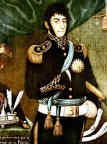 Without economic resources, Hipólito Bouchard was presented to General San Martín and begged him to let him return to Argentina. But the Liberator was asked five months, perhaps thinking of giving the command of the Peruvian Navy after release (28 July 1821, José de San Martín proclaimed the independence of Lima).
Without economic resources, Hipólito Bouchard was presented to General San Martín and begged him to let him return to Argentina. But the Liberator was asked five months, perhaps thinking of giving the command of the Peruvian Navy after release (28 July 1821, José de San Martín proclaimed the independence of Lima).
When Cochrane took over Lima flows deposited in their warships, under the pretext of collecting assets owed, San Martín organized the Peruvian Navy and Bouchard gave the command of the frigate "Test", the ship more important in the fleet. Lord Cochrane feared confrontation with the hero francoargentino and reversed.
The End, Far from the Sea
Until 1828 Hipólito Bouchard continued serving the Peruvian Navy. Then he retired and settled in the haciendas of San Javier and San José de Nazca, awarded as a reward for the Peruvian Congress. Bouchard founded a large sugar mill, which he called "Good Luck. Then, the United Provinces no longer bled into civil war. The hero of yesteryear never saw his wife or his daughters, and became increasingly sullen. His anger exploded at any moment and was discharged violently, just him, the liberator of slaves, against the pawns of their estates.
On the evening of January 4, 1837 struck a servant, but this time, there were violent protests. Hipólito Bouchard took a pistol and saber old approach, but it was too late. The servant was killed by stabbing.
His remains were lost for more than 120 years, until June 1962 were found in a forgotten crypt of a church in Nazca, Peru. On 6 July of that year, the remains were exhumed by a joint committee of the marine Argentina and Peru and repatriated to Buenos Aires aboard a cruise called "Argentina." Now rest in the Pantheon of Buenos Aires.
Notes (1) A relic these times is in the current Constitution of Argentina. Article 75 (which was 67 before the constitutional reform of 1994), which has the powers of Congress, says in paragraph 26 (formerly the 22): "To grant letters of marque and reprisal, and make regulations for dams ".
(2) Each July 9, the commune of Bormes at a ceremony commemorating the independence of Argentina, paying homage to his adopted country of one of their beloved children.
(3) in Santa Barbara can be seen in a long pier to the beach, tall masts with flags of nations that once occupied California: Spain, Russia, Mexico, United States y. .. Argentina. On the second floor the County Court House is a mural that represents the occupation of 1818.
(4) A San Juan Capistrano arrive in the spring, the swallows that migrate from Argentina. In what is now Dana Point are still remembers the attack by Hipólito Bouchard to San Juan Capistrano, with the annual Fiesta del Pirata. It is clear that, for most Anglo-Saxon texts, Bouchard is a mere pirate. One of the few that does justice is Peter Uhrowczik, in his book "The Burning of Monterey: The 1818 Attack on California by the Privateer Bouchard, Cyril Books, 2001. To my knowledge, there is no English version. Books
The best possible source, a century or later remains the work of Bartolome Mitre, "The cruise of Argentina 1817-1819", included in "Pages of History", you can download (in. pdf, 757 Kb) http://www. e-libro.net/E-libro-viejo/libros_gratis.htm .
"The Eagle Warrior." Pacho O'Donnell, Editorial Sudamericana, 1998.
"Corsairs Argentines." Miguel Angel de Marco, Editorial Planeta, 2002. Articles
"When Hawaii was flag of Argentina." Conrado Etchebarne Bullrich. The Nation, Supplement Approaches, Sunday 14 September 1997.
Links
article detailed
Armada Argentina
About Napoleon
Rescue Stories
Trip Around the World
Bouchard Biography
What is a Letter of Marque?
0 comments:
Post a Comment